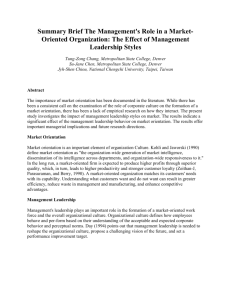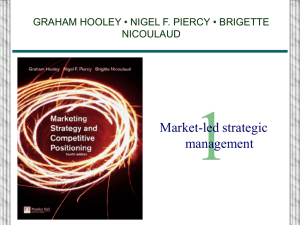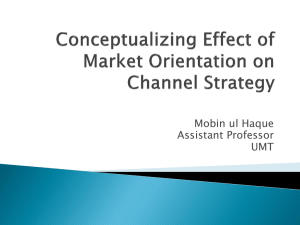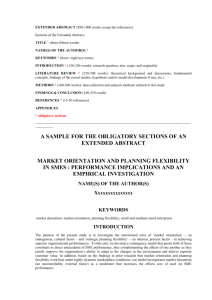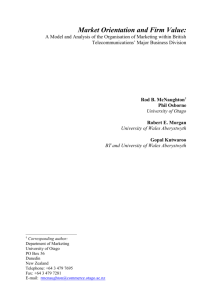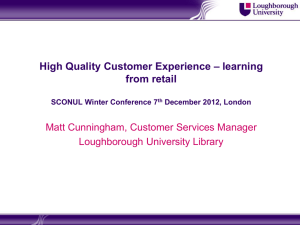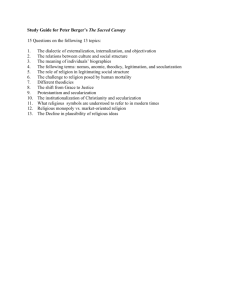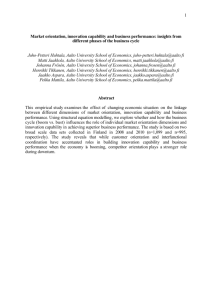RESEARCH NOTES AND COMMUNICATIONS CUSTOMER
advertisement
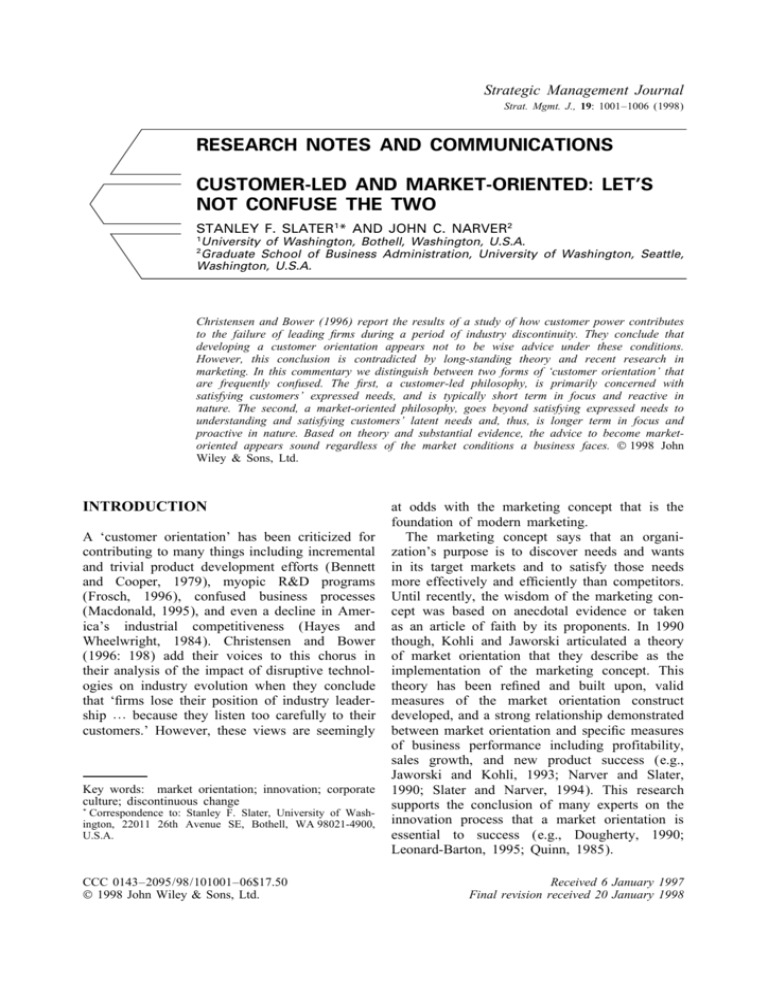
Strategic Management Journal Strat. Mgmt. J., 19: 1001–1006 (1998) RESEARCH NOTES AND COMMUNICATIONS CUSTOMER-LED AND MARKET-ORIENTED: LET’S NOT CONFUSE THE TWO STANLEY F. SLATER1* AND JOHN C. NARVER2 1 University of Washington, Bothell, Washington, U.S.A. Graduate School of Business Administration, University of Washington, Seattle, Washington, U.S.A. 2 Christensen and Bower (1996) report the results of a study of how customer power contributes to the failure of leading firms during a period of industry discontinuity. They conclude that developing a customer orientation appears not to be wise advice under these conditions. However, this conclusion is contradicted by long-standing theory and recent research in marketing. In this commentary we distinguish between two forms of ‘customer orientation’ that are frequently confused. The first, a customer-led philosophy, is primarily concerned with satisfying customers’ expressed needs, and is typically short term in focus and reactive in nature. The second, a market-oriented philosophy, goes beyond satisfying expressed needs to understanding and satisfying customers’ latent needs and, thus, is longer term in focus and proactive in nature. Based on theory and substantial evidence, the advice to become marketoriented appears sound regardless of the market conditions a business faces. © 1998 John Wiley & Sons, Ltd. INTRODUCTION A ‘customer orientation’ has been criticized for contributing to many things including incremental and trivial product development efforts (Bennett and Cooper, 1979), myopic R&D programs (Frosch, 1996), confused business processes (Macdonald, 1995), and even a decline in America’s industrial competitiveness (Hayes and Wheelwright, 1984). Christensen and Bower (1996: 198) add their voices to this chorus in their analysis of the impact of disruptive technologies on industry evolution when they conclude that ‘firms lose their position of industry leadership % because they listen too carefully to their customers.’ However, these views are seemingly Key words: market orientation; innovation; corporate culture; discontinuous change * Correspondence to: Stanley F. Slater, University of Washington, 22011 26th Avenue SE, Bothell, WA 98021-4900, U.S.A. CCC 0143–2095/98/101001–06$17.50 © 1998 John Wiley & Sons, Ltd. at odds with the marketing concept that is the foundation of modern marketing. The marketing concept says that an organization’s purpose is to discover needs and wants in its target markets and to satisfy those needs more effectively and efficiently than competitors. Until recently, the wisdom of the marketing concept was based on anecdotal evidence or taken as an article of faith by its proponents. In 1990 though, Kohli and Jaworski articulated a theory of market orientation that they describe as the implementation of the marketing concept. This theory has been refined and built upon, valid measures of the market orientation construct developed, and a strong relationship demonstrated between market orientation and specific measures of business performance including profitability, sales growth, and new product success (e.g., Jaworski and Kohli, 1993; Narver and Slater, 1990; Slater and Narver, 1994). This research supports the conclusion of many experts on the innovation process that a market orientation is essential to success (e.g., Dougherty, 1990; Leonard-Barton, 1995; Quinn, 1985). Received 6 January 1997 Final revision received 20 January 1998 1002 S. F. Slater and J. C. Narver If the nature and benefits of being marketoriented are so well documented in the marketing literature, why does this debate continue in the management literature? We propose that the problem has occurred because, without realizing it, scholars are talking about two separate management philosophies. The first, being ‘customerled,’ is a short-term philosophy in which organizations respond to customers’ expressed wants. The second, being ‘market-oriented,’ represents a long-term commitment to understanding customer needs—both expressed and latent—and to developing innovative solutions that produce superior customer value. In the remainder of this commentary we differentiate between these two philosophies and describe the conditions under which each may be successful. THE CUSTOMER-LED BUSINESS Customer-led businesses focus on understanding the expressed desires of the customers in their served markets and on developing products and services that satisfy those desires. Typically, customer-led businesses use focus groups and customer surveys to enhance their understanding of customer wants and perceptions of current products and services, and techniques such as concept testing and conjoint analysis to guide the development of new products and services (e.g., Leonard and Rayport, 1997). Customer-led businesses may also develop close relationships with important customers to gain deeper insight into those customers’ desires. Retail banking is one industry that has widely adopted this philosophy with good results (e.g., Timewell, 1994). Many successful banks have developed customer information files from data that are routinely collected in a bank’s various production systems to improve their segmentation and targeting efforts (Bank Management, 1996). On the surface the customer-led philosophy seems sensible and compelling. What is the problem with it? The problem is that the philosophy is reactive and short term in focus, and generally leads to adaptive rather than generative learning (Senge, 1990). The first troublesome aspect of it is what Hamel and Prahalad (1994) call the ‘tyranny of the served market’ in which managers see the world only through their current customers’ eyes. As Christensen and Bower (1996) © 1998 John Wiley & Sons, Ltd. point out, existing customers can substantially constrain a firm’s ability to innovate because the innovations may threaten the customers’ way of doing business. Hamel and Prahalad (1994: 99) lend their support when they comment, ‘Customers are notoriously lacking in foresight.’ In the disk-drive industry, the core competency that satisfied customers became a core rigidity as managers were unwilling to risk displeasing existing, powerful customers. Furthermore, the value of traditional market research tools is limited when it comes to developing innovative products or services (Hamel and Prahalad, 1994). These techniques rely on users being capable of articulating their needs and also being able to help devise solutions to those needs. However, latent needs cannot be articulated and, thus, other approaches to learning about markets must be utilized (Leonard-Barton, 1995; Lynn, Morone, and Paulson, 1996). As positive as pursuing increased customer satisfaction seems, it also brings a set of difficult problems. The first is the development of a valid measure of customer satisfaction. Customer satisfaction surveys are unreliable indicators of intention to purchase or the likelihood of repeat business. Many times they are poorly conceived and conducted, measure the wrong activity or customers, or do not assess relative value or satisfaction (Reichheld, 1996). A second problem is that if efforts to measure customer satisfaction overwhelm other strategic performance indicators such as those concerned with new product success or organizational learning, management is likely to focus only on the short term. This could easily discourage risk taking in both product and process development, thus leading only to incremental improvements in current products and service activities. THE MARKET-ORIENTED BUSINESS On the surface, market-oriented businesses resemble customer-led businesses. This is an important source of confusion about what is market-oriented and what is customer-led. Following is a description of behaviors that are bedrock values in the market-oriented business. Though these behaviors may, at times, be present in a customer-led business, they are permanent elements of a market-oriented business. Strat. Mgmt. J., 19: 1001–1006 (1998) Research Notes and Communications Market-oriented businesses are committed to understanding both the expressed and latent needs of their customers, and the capabilities and plans of their competitors through the processes of acquiring and evaluating market information in a systematic and anticipatory manner. They continuously create superior customer value by sharing the knowledge broadly throughout the organization and by acting in a coordinated and focused manner (e.g., Slater and Narver, 1995). Compared to customer-led businesses, market-oriented businesses scan the market more broadly, have a longer-term focus, and are much more likely to be generative learners. Generative learning is critical to innovation (Senge, 1990). No information ‘is more important to a technology-based firm than information flowing in from the market, as this information shapes science into commercial product or service’ (Leonard-Barton, 1995: 177). Although marketoriented businesses use many of the same traditional market research techniques as customerled businesses, they combine these with other techniques to discover customers’ latent needs and to drive generative learning. For example, they observe closely customers’ use of products or services in normal routines. By observing in context, they acquire information about customer needs that is not available from traditional market research (Leonard and Rayport, 1997). They also work closely with lead users (Tabrizi and Walleigh, 1997). A lead user to a marketoriented business is quite different from what Christensen and Bower (1996) describe, however. Rather than merely being large customers that currently are very important to the business, they are customers, or potential customers, who have needs that are advanced compared to other market members and who expect to benefit significantly from a solution to those needs (von Hippel, 1986). ‘To push out the boundaries of current product concepts, it is necessary to put the most advanced technology possible directly into the hands of the world’s most sophisticated and demanding users’ (Hamel and Prahalad, 1994: 102). This type of exploration often leads to the discovery of new solutions to unexpressed needs (Leonard-Barton, 1995). Thus, a true lead user should be a window into the future and not an anchor in the past. Of course the future can never be fully known in a dynamic and turbulent market. Therefore, © 1998 John Wiley & Sons, Ltd. 1003 for generative learning, market-oriented businesses conduct market experiments, learn from the results of those experiments, and modify their offerings based on the new knowledge and insights (Hamel and Prahalad, 1994; Slater and Narver, 1995). Lynn et al. (1996; see also Leonard-Barton, 1995; Morone, 1993) describe how companies such as Motorola, General Electric, and Corning maintain strong market positions by utilizing the ‘probe and learn process.’ In this process, the initial product is only the first step in the development process, not its culmination. The initial product is a prototype that becomes the foundation for subsequent, more-refined generations that follow. Of course, this requires both financial and managerial commitment. However, strong leadership is a characteristic of marketoriented businesses. Market-oriented businesses also escape the tyranny of the served market by searching for unserved markets (Hamel and Prahalad, 1994). The unserved market represents potential—those who might be customers. New products and unserved markets are the catalyst for organizational renewal in the market-oriented business. A final point is that a market orientation is not a marketing orientation. Marketing is only one function of the business. A business is marketoriented only when the entire organization embraces the values implicit therein and when all business processes are directed at creating superior customer value. IMPLICATIONS FOR COMPETITIVE ADVANTAGE Is either of these philosophies a source of competitive advantage? An organization has a foundation for sustained competitive advantage when it possesses skills or resources that provide superior value to customers and that are difficult to imitate. Table 1 illustrates the key features of each approach. In a relatively stable environment (e.g., retail banking), responding quickly to evolving customer wants and focusing on customer satisfaction may provide the foundation that enduring relationships are built upon. These relationships can be durable and valuable, and thus provide a foundation for competitive advantage (Reichheld, 1996). In a turbulent environment though, the Strat. Mgmt. J., 19: 1001–1006 (1998) 1004 S. F. Slater and J. C. Narver Table 1. Key differences between customer-led and market-oriented Customer-led Strategic orientation Adjustment style Temporal focus Objective Learning type Learning processes Market-oriented Expressed wants Latent needs Responsive Short-term Customer satisfaction Adaptive Customer surveys Proactive Long-term Customer value Key account relationships Focus groups Concept testing Generative Customer observation Lead-user relationships Continuous experimentation Selective partnering more enduring advantage is an ability to anticipate evolving customer needs and to generate new value-creating capabilities based on that knowledge (D’Aveni, 1994; Leonard-Barton, 1995). Successful technology-based innovations must be accepted first by early adopters who tend to be market visionaries. Their expectation is to exploit the new technology to achieve advantage over their competitors who use the old solution. They are willing to accept a partial, but potentially superior, solution from the supplier and to work closely with the supplier to refine the technology or the product to meet their needs. However, these visionaries often are small individually and collectively with respect to the potential market. They are the true lead-users though, so market-oriented suppliers expend considerable effort to identify and work closely with members of this market segment to develop and to refine the concept (Moore, 1991). This is a critical step in the commercialization of the technology as the solution embraced by the visionaries becomes the core of the product that will be adopted by early majority buyers. The early majority are pragmatists in that they require a clear understanding of how adoption of the new technology will create economic value for them. Pragmatists require the supplier to produce a whole solution that is more effective or efficient than the buyers’ current solution. Pragmatists are unlikely to be true lead-users © 1998 John Wiley & Sons, Ltd. because of their investment in and commitment to the traditional solution. However, the marketoriented supplier must work effectively with the pragmatists to demonstrate economic value because the pragmatists represent the mainstream market (Moore, 1995). We suggest that the lead-users that Chistensen and Bower characterize as myopic are actually pragmatists. The market-oriented business values both visionaries and pragmatists but can discern between them and can develop appropriate relationships with each. The ability of the marketoriented business to facilitate the development of innovative products is supported by AtahueneGima’s (1995: 287) finding that ‘market orientation is more strongly related to new product performance at the early stage of the product life cycle than at the late stage . . . Such an environment seems to warrant greater market intelligence and information sharing within the firm.’ Also, since the market-oriented business takes the long-term view, it is willing to cannibalize sales of existing products by introducing nextgeneration products. As Hewlett-Packard’s CEO, Lew Platt, has said, ‘If we don’t eat our own lunch, somebody else will’ (Moore, 1995: 85). Other recognized innovators such as Motorola, Monsanto, Corning, General Electric, and Intel follow the same philosophy and focus their R&D efforts on market-defined opportunities. In other words, their innovations are the result of a technology capability that is shaped by an understanding of latent market needs (Morone, 1993). Thus, a market orientation consists of norms for behavior that guide the business in learning quickly from and about different types of needs, and responding in an entrepreneurial manner to deliver superior customer value. The capabilities arising from a market orientation enable the business to identify and exploit discontinuities in its served market(s) as well as unserved markets. As a form of business culture, a market orientation is difficult for competitors to observe and understand, much less to imitate (Slater and Narver, 1995) and, thus, is a competitive advantage (Barney, 1986). CONCLUSION It is important to recognize that the customerled and market-oriented philosophies represent Strat. Mgmt. J., 19: 1001–1006 (1998) Research Notes and Communications different degrees to which businesses actively attempt to understand their markets. A customerled philosophy tends to be reactive and short term in its orientation, and focuses on customers’ expressed desires and on measures of customer satisfaction. Being customer-led may be successful in relatively predictable environments where it is most important to take care of a stable served market. It also may be attractive to some managers in dynamic environments because of the uncertainty and risk associated with attempting to lead the customer. However, being customer-led in a dynamic environment will rarely lead to a position of competitive advantage since it provides insufficient stimulus for the significant innovation that discontinuous change requires. Peter Drucker (1974) suggested that the two essential activities of business are ‘innovation’ and ‘marketing.’ Without the other, neither is sufficient for long-term success. A market orientation is concerned with understanding both expressed and latent customer needs. Like customer-led businesses, market-oriented businesses listen closely to the voices of their customers. However, they recognize that different types of customers provide different types of information. Moreover, those voices are only one source of information on which plans and strategies should be based. Their commitment to continuous market learning, to discovering latent needs and unserved markets, and to organization-wide mobilization of resources, enables them to achieve marketfocused innovation and to sustain competitive advantage in all types of markets. ACKNOWLEDGEMENTS We gratefully acknowledge the Marketing Science Institute’s support of our research in this area and the helpful comments of two anonymous SMJ reviewers. REFERENCES Atuahene-Gima, K. (1995). ‘An exploratory analysis of the impact of market orientation on new product performance’, Journal of Product Innovation Management, 12, pp. 275–293. Bank Management (January–February 1996). ‘Database marketing: Leveraging the bank’s information assets’, pp. 32b-32d. © 1998 John Wiley & Sons, Ltd. 1005 Barney, J. (1986). ‘Organizational culture: Can it be a source of sustained competitive advantage?’, Academy of Management Review, 11, pp. 656–665. Bennett, R. and R. Cooper (June 1979). ‘Beyond the marketing concept’, Business Horizons, pp. 76–83. Christensen, C. and J. Bower (1996). ‘Customer power, strategic investment, and the failure of leading firms’, Strategic Management Journal, 17(3), pp. 197–218. D’Aveni, R. (1994). Hypercompetition: Managing the Dynamics of Strategic Maneuvering. Free Press, New York. Dougherty, D. (1990). ‘Understanding new markets for new products’, Strategic Management Journal, Summer Special Issue, 11, pp. 59–78. Drucker, P. (1974). Management: Tasks, Responsibilities, Practices. Harper & Row, New York. Frosch, R. (November–December 1996). ‘The customer for R&D is always wrong!’, Research-Technology Management, pp. 22–27. Hamel, G. and C. K. Prahalad (1994). Competing for the Future. Harvard Business School Press, Boston, MA. Hayes, R. and S. Wheelwright (1984). Restoring our Competitive Edge: Competing Through Manufacturing. Wiley, New York. Jaworski, B. and A. Kohli (July 1993). ‘Market orientation: Antecedents and consequences’, Journal of Marketing, 57, pp. 53–70. Kohli, A. and B. Jaworski (April 1990). ‘Market orientation: The construct, research propositions, and managerial implications’, Journal of Marketing, 54, pp. 1–18. Leonard-Barton, D. (1995). Wellsprings of Knowledge. Harvard Business School Press, Boston, MA. Leonard, D. and J. Rayport (1997). ‘Spark innovation through empathic design’, Harvard Business Review, 75(6), pp. 102–113. Lynn, G., J. Morone and A. Paulson (1996). ‘Marketing and discontinuous innovation: The probe and learn process’, California Management Review, 38(3), pp. 8–37. Macdonald, S. (1995). ‘Too close for comfort: The strategic implications of getting close to the customer’, California Management Review, 37(4), pp. 8–27. Moore, G. (1991). Crossing the Chasm. HarperBusiness, New York. Moore, G. (1995). Inside the Tornado. HarperBusiness, New York. Morone, J. (1993). Winning in High-Tech Markets. Harvard Business School Press, Boston, MA. Narver, J. and S. Slater (October 1990). ‘The effect of a market orientation on business profitability’, Journal of Marketing, 54, pp. 20–35. Quinn, J. B. (1985). ‘Managing innovation: Controlled chaos’, Harvard Business Review, 63(3), pp. 73–84. Reichheld, F. (1996). ‘Learning from customer defections’, Harvard Business Review, 74(2), pp. 56–70. Senge, P. M. (1990). The Fifth Discipline. Doubleday, New York. Slater, S. and J. Narver (1994). ‘Does competitive Strat. Mgmt. J., 19: 1001–1006 (1998) 1006 S. F. Slater and J. C. Narver environment moderate the market orientation– performance relationship?’, Journal of Marketing, 58(1), pp. 46–55. Slater, S. and J. Narver (1995). ‘Market orientation and the learning organization’, Journal of Marketing, 59(3), pp. 63–74. Tabrizi, B. and R. Walleigh (1997). ‘Defining next- © 1998 John Wiley & Sons, Ltd. generation products: An inside look’, Harvard Business Review, 75(6), pp. 116–124. Timewell, S. (February 1994). ‘Listen to the customer’, Banker, pp. 29–30. von Hippel, E. (July 1986). ‘Lead users: A source of novel product concepts’, Management Science, 32, pp. 791–805. Strat. Mgmt. J., 19: 1001–1006 (1998)
